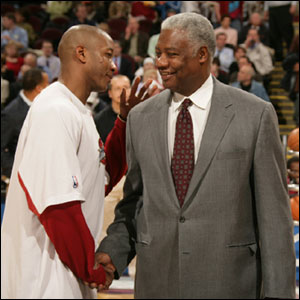
|
2006-07 NBA season marks 30th Anniversary of the
Oscar Robertson Rule, landmark court decision which changed the balance of power in pro sports |
|||||
|
On April 16, 1970, in US District Court, the Southern District of New York, Oscar Robertson, as president of the National Basketball Players Association and as player representative for the Cincinnati Royals, filed a class-action lawsuit against the NBA and its 14 teams. Player reps from the other 13 franchises were co-plaintiffs. On April 29, 1976, the NBA - which now had 18 teams - agreed to a class action settlement with the Players Association which changed the balance of power in professional sports. Players now had leverage in dealing with owners. MLB and NFL players soon won similar concessions.
The settlement, which became known as the Oscar Robertson Rule, eliminated the "option" or "reserve" clause in the NBA's uniform player contract (which bound a player to one team for life at the team's option), and was the first step toward unrestricted free agency in the NBA.
The draft was modified - a player could sit out a year and re-enter instead of signing with the team that drafted him, and high school graduates became eligible - as were the right of first refusal and compensation rules which had restricted player movement among teams.
The suit was filed primarily to halt a merger between the NBA and the American Basketball Association, then concluding its third season, until antitrust issues with respect to the NBA's uniform player contract could be resolved.
The Big O had an economic incentive for filing the suit as well. He felt that if professional
athletes were paid on a par with star entertainers, fan interest would grow and NBA franchises would prosper accordingly. Time has proven him right. The NBA Players Association won a significant victory almost immediately when the NBA was enjoined from pursuing a merger with the ABA pending resolution of those antitrust issues.
The NBA and ABA attempted to override the injunction with a Senate bill exempting them from antitrust law, as the NFL had done four years earlier in order to merge with the AFL. This ploy backfired, however, as Senator Sam Ervin, Senate antitrust subcommittee chairman, convened hearings in 1971 at which Robertson and other NBA and ABA players, plus league officials and owners, testified. The proposed bill never made it out of committee.
Meanwhile, litigation had been stalled for two years until a new judge picked up the case. He
was Robert L. Carter, a former general counsel to the NAACP who had written the brief for and argued the Brown vs. the Board of Education case before the U.S. Supreme Court in 1954. He ruled that the suit indeed qualified for class action status and was a valid complaint on anti-trust grounds. Following the discovery process, during which more than 250 depositions were taken, the settlement was reached literally on the eve of the scheduled trial date. |
 Eric Snow, player representative for the Cleveland Cavaliers,
recognized Oscar Robertson for his years of leadership on behalf of NBA players when The Big O was honored at Quicken Loans Arena in January 2006. (Photo courtesy of the Cleveland Cavaliers.) “The 30th Anniversary of the Oscar Robertson rule is a poignant reminder of our game's history and its tremendous evolution as a result of resolute pioneers like Oscar Robertson. His contributions to professional basketball are second to none, as is his tremendous dedication to the well-being of former players. As a role model, both on and off the court, Oscar, one of our esteemed NBRPA Founders, continues to make a difference in our game - past, present and future.”
— Len Elmore, President, National Basketball Retired Players Association
Following the settlement, the ABA disbanded and four of its teams joined the NBA: Denver, Indiana, New York (now New Jersey) Nets and San Antonio. The NBA also set aside $4.3 million to compensate 479 players who were active from 1966-67 through 1975- 76 with anywhere from $1991 up to $29,865, depending on the player's length of service.
The firm of Weil, Gotshal and Manges represented the NBA Players Association, with Ira Millstein as lead attorney, succeeded by Peter Gruenberger and James W. Quinn. The firm of Proskauer, Rose, Goetz & Mendelsohn represented the NBA, with David Stern as lead attorney. Stern became NBA general counsel in 1978 and commissioner in 1984. Instead of destroying the league, as the owners had claimed it would, the Oscar Robertson Rule ushered in a new era of growth and prosperity for the NBA. Oscar Robertson had already been retired for two years when the suit bearing his name was settled. More:
|
||||
|
We are grateful to James W. Quinn, Esq. for providing additional material on this case.
Read William C. Rhoden's New York Times column about the Oscar Robertson Rule (registration required) 6/10/2024
|
|||||






